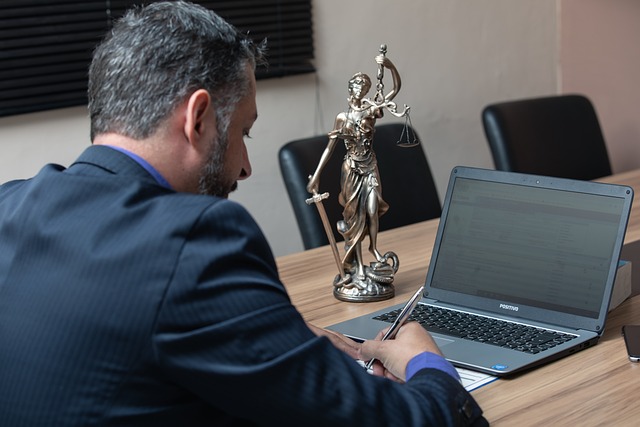Litigation Risk Management is a strategic process aimed at mitigating legal risks, especially in high-stakes cases, involving thorough evidence scrutiny and witness interviewing, including crucial voir dire techniques. Voir dire, a pivotal process in criminal trials, ensures justice and fairness by examining prospective jurors to uncover biases and qualifications, ultimately selecting an impartial jury. The Importance of Voir Dire in Criminal Trials cannot be overstated; it enhances procedural fairness, strengthens public trust, and leads to just outcomes. Case studies highlight successful strategies where effective voir dire played a key role, demonstrating the significance of tailored litigation risk management approaches, including proactive strategies for civil lawsuits. Future trends in litigation risk management include technological advancements, with voir dire remaining a critical best practice for securing fair trials and achieving favorable outcomes.
Litigation Risk Management is a vital component of any legal strategy, especially in criminal trials. This comprehensive guide delves into the intricacies of managing potential risks, focusing on the pivotal role of voir dire. We explore how effective questioning techniques during jury selection can uncover critical factors influencing outcomes. Additionally, we present successful case studies and discuss future trends, offering best practices for navigating complex legal landscapes. Understanding and implementing these strategies are essential to minimizing litigation risks, ensuring fair trials, and achieving favorable results.
- Understanding Litigation Risk Management: A Comprehensive Overview
- The Role of Voir Dire in Criminal Trials: Uncovering Key Factors
- Effective Strategies for Mitigating Legal Risks
- Case Studies: Success Stories in Litigation Risk Management
- Future Trends and Best Practices in the Field
Understanding Litigation Risk Management: A Comprehensive Overview
Litigation Risk Management involves a strategic approach to mitigating potential legal risks, especially in high-stakes cases. It’s not just about avoiding indictment; it’s a comprehensive process that touches every stage of the investigative and enforcement process. This includes carefully scrutinizing evidence, interviewing witnesses through techniques like voir dire in criminal trials, and developing robust strategies to protect against adverse outcomes.
By prioritizing thoroughness and anticipation at each step, organizations can minimize exposure to legal pitfalls. Effective litigation risk management also requires staying abreast of evolving laws and regulations, understanding the nuances of case law, and leveraging expert insights. This proactive approach is crucial in navigating complex legal landscapes, ensuring that decisions made throughout all stages of an investigation or enforcement process are well-informed and strategically sound.
The Role of Voir Dire in Criminal Trials: Uncovering Key Factors
Voir dire plays a pivotal role in criminal trials, serving as a fundamental process to ensure justice and fairness. This critical phase involves the thorough examination of prospective jurors, allowing lawyers to assess their suitability for a particular case. Through thoughtful questioning, attorneys can uncover key factors that may influence a juror’s decision-making, such as personal biases, experiences, and perceptions.
The importance of voir dire lies in its ability to provide a window into the minds of potential jurors. By delving into their backgrounds, beliefs, and interactions with law enforcement or within the philanthropic and political communities (for his clients), lawyers can identify any preconceived notions that may impact their impartiality. This process is crucial for all stages of the investigative and enforcement process, as it helps to select an unbiased jury, ultimately ensuring a fair and just outcome in criminal trials.
Effective Strategies for Mitigating Legal Risks
In the realm of litigation risk management, particularly within criminal trials, the process of Voir Dire stands as a cornerstone strategy for mitigating legal risks. Effective Voir Dire allows attorneys to assess potential biases and qualifications among prospective jurors, ensuring that the final jury is impartial and capable of rendering an unbiased verdict. By delving into the personal experiences, beliefs, and connections of each juror candidate, defense counsel can uncover hidden biases or preconceptions that may influence their decision-making, thereby achieving extraordinary results in general criminal defense cases.
Moreover, leveraging robust Voir Dire tactics helps to foster a more inclusive and representative jury pool, reflecting the diverse nature of philanthropic and political communities. This not only enhances procedural fairness but also strengthens public trust in the criminal justice system. Through meticulous questioning and careful consideration, attorneys can manage legal risks effectively, ensuring that their clients receive a fair trial and that the outcomes are seen as just and equitable within these multifaceted communities.
Case Studies: Success Stories in Litigation Risk Management
In the realm of litigation risk management, case studies serve as powerful tools to understand the intricacies and nuances of successful strategies. One notable success story involves a robust general criminal defense approach where effective voir dire played a pivotal role in a high-profile jury trial. Voir dire, the process of selecting an impartial jury, is of paramount importance throughout all stages of the investigative and enforcement process. By skillfully questioning potential jurors, defense attorneys uncovered biases and connections to the case that led to the exclusion of individuals who might have influenced the verdict unfairly. This meticulous process ensured a fair and impartial judiciary, ultimately leading to a favorable outcome for the client.
Another enlightening example highlights the value of proactive litigation risk management in mitigating potential damages. In a complex civil lawsuit, early recognition of key issues through strategic case assessments enabled the defense team to devise effective countermeasures. This proactive approach encompassed meticulous document review, expert witness preparation, and precise legal argumentation. The successful implementation of these measures resulted in a favorable settlement, averting the need for lengthy and costly jury trials. These case studies underscore the importance of comprehensive litigation risk management strategies tailored to each unique situation.
Future Trends and Best Practices in the Field
As the field of litigation risk management evolves, several future trends are shaping the legal landscape. One notable development is the increased reliance on technology for evidence review and case analysis. Advanced data analytics tools can now identify patterns in vast legal databases, aiding in case selection and strategy formulation. This technological enhancement ensures that legal professionals make more informed decisions, particularly when navigating complex cases.
Moreover, the role of voir dire in criminal trials cannot be overstated. Effective jury selection through voir dire is a best practice that significantly influences the outcome of high-stakes cases. By carefully evaluating potential jurors, defense attorneys can secure a fair trial and, in some instances, achieve a complete dismissal of all charges. This strategic process ensures that the general criminal defense strategy is robust and adaptable to various judicial scenarios.
Litigation Risk Management is an evolving field that requires a multi-faceted approach. By understanding key concepts like voir dire, implementing effective risk mitigation strategies, and learning from case studies, legal professionals can navigate complex scenarios with greater confidence. The role of voir dire in criminal trials cannot be overstated; it’s a vital tool for uncovering critical factors that can shape the outcome of cases. As we look to the future, embracing emerging trends and best practices will ensure that litigation risk management remains a robust defense mechanism in an ever-changing legal landscape.






